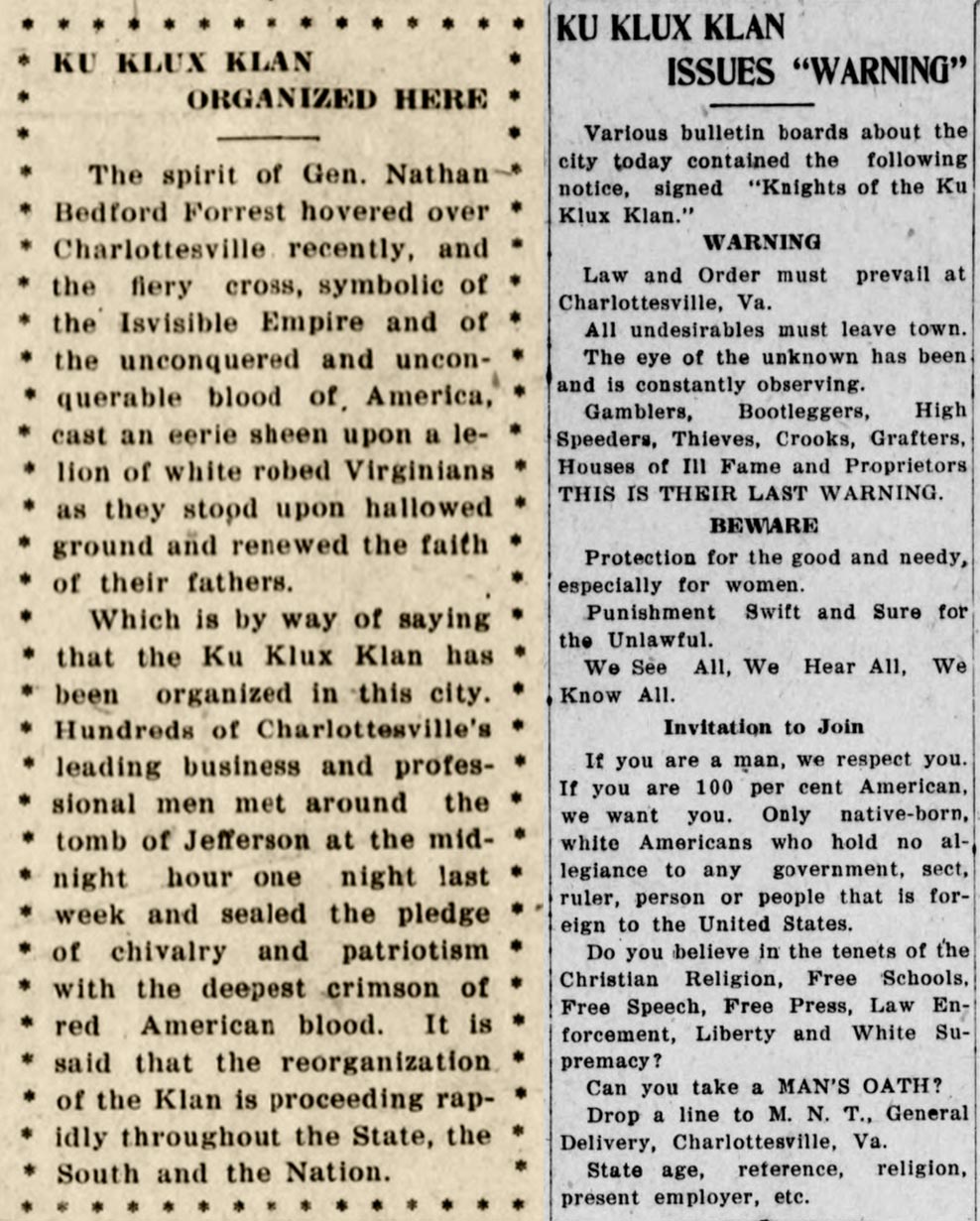__________________________
Notes
1. Thanks to the Charlottesville Mayor’s Blue Ribbon Commission on Race, Memorials, and Public Spaces for their research and historical timeline published as an appendix to their report, which first published details about Klan activity in the area 1917-1924 (see appendix which starts on p. 71 of document): https://www.charlottesville.org/home/showdocument?id=49037
2. “Hallowe’en Is Duly Observed.” Daily Progress, Wednesday November 1, 1916, p. 1. http://search.lib.virginia.edu/catalog/uva-lib:2108782/view#openLayer/uva-lib:2108783/2719.5/2701.5/4/1/0
3. “At the Theatres,” Daily Progress, January 24, 1924, p. 1, http://search.lib.virginia.edu/catalog/uva-lib:2589088/view#openLayer/uva-lib:2589089/1560/1956/4/1/1 and “Avoid the Crowd,” Daily Progress, January 25, 1924, p. 1 http://search.lib.virginia.edu/catalog/uva-lib:2589097/view#openLayer/uva-lib:2589098/1117/1613.5/3/1/0
4. “Held Under Suspicion,” Daily Progress, April 10, 1917, p. 1. http://search.lib.virginia.edu/catalog/uva-lib:2109812/view#openLayer/uva-lib:2109813/1585.5/2671/4/1/0
5. “Sub Policeman Is Murdered,” Daily Progress, Friday April 13, 1917, p. 1, http://search.lib.virginia.edu/catalog/uva-lib:2109833/view#openLayer/uva-lib:2109834/5345/1218.5/3/1/0 and “Raise Fund for Officer Thomas’ Widow” Daily Progress, Monday April 16, 1917, p. 1, http://search.lib.virginia.edu/catalog/uva-lib:2109851/view#openLayer/uva-lib:2109852/4370/2286.5/3/1/0 and advertisement, p. 3, http://search.lib.virginia.edu/catalog/uva-lib:2119725/view#openLayer/uva-lib:2119728/5153.5/2738/2/1/0
6. “Cosby Shot Thomas,” Daily Progress, Saturday April 14, 1917, p. 1. http://search.lib.virginia.edu/catalog/uva-lib:2109842/view#openLayer/uva-lib:2109843/1516/1562.5/3/1/0
7. “Lynching Party Is Dispersed,” Daily Progress, Tuesday April 17, 1917, pp. 1 and 8, http://search.lib.virginia.edu/catalog/uva-lib:2109858/view#openLayer/uva-lib:2109859/5314.5/3041/3/1/0
8. “Judge Scatters Mob,” Baltimore Sun, Wednesday, April 18, 1917, p. 6.
9. “Men Die In Electric Chair,” Daily Progress, June 20, 1917, p. 1. http://search.lib.virginia.edu/catalog/uva-lib:2110265/view#openLayer/uva-lib:2110266/5348/4961.5/3/1/0
10. “J.P. Morgan, the Ku Klux Klan And Youngest Descendant of Thomas Jefferson Contribute to U. of Va. Fund,” Alexandria Gazette, Wednesday, March 23, 1921, p. 2; and “Ku Klux Klan Gives a Thousand Dollars to Gymnasium Fund,” College Topics, March 25, 1921, p. 1-2.
11. “Ku Klux Klan Organized Here,” Daily Progress, Tuesday June 28, 1921, p. 1. http://search.lib.virginia.edu/catalog/uva-lib:2119582/view#openLayer/uva-lib:2119583/4557.5/1559/3/1/0
12. “Ku Klux Klan Issues ‘Warning’,” Daily Progress, July 19, 1921, p. 1. http://search.lib.virginia.edu/catalog/uva-lib:2119725/view#openLayer/uva-lib:2119726/5244/3480.5/3/1/0
13. “Ku Klux Klan at Thomas Funeral,” Richmond Planet, February 18, 1922, p. 1. https://virginiachronicle.com/cgi-bin/virginia?a=d&d=RP19220218.1.1&srpos=1&e=--1922---1922--en-20-RP-1-byDA-txt-txIN-Charlottesville------
14. “U. of VA. Klan No. 5,” Daily Progress, November 6, 1922, p. 1 http://search.lib.virginia.edu/catalog/uva-lib:2123262/view#openLayer/uva-lib:2123263/3474/3101.5/3/1/0
15. “Ku Klux Klan: Grand Dragon of State Visits Charlottesville,” Daily Progress, August 23, 1922, p. 1 http://search.lib.virginia.edu/catalog/uva-lib:2122694/view#openLayer/uva-lib:2122695/4367/1723/3/1/1 and p. 3 http://search.lib.virginia.edu/catalog/uva-lib:2122694/view#openLayer/uva-lib:2122697/5752/3804.5/3/1/0
16. “Klan Speaker Here Last Night,” Daily Progress, April 26, 1924, p. 1 http://search.lib.virginia.edu/catalog/uva-lib:2589938/view#openLayer/uva-lib:2589939/1657/3566/3/1/0 and “Klan Speaker Well Received,” Daily Progress, June 9, 1924, p. 1 http://search.lib.virginia.edu/catalog/uva-lib:2590289/view#openLayer/uva-lib:2590290/3005/2741/3/1/0
17. Thomas L. Rosser Jr. letter to his daughter Barbara, May 24, 1924, University of Virginia, Special Collections, MSS 1171-g, -h, -j, Box 7.
18. “Cross Burned on Patterson’s Mountain,” Daily Progress, May 17, 1924, p. 1 http://search.lib.virginia.edu/catalog/uva-lib:2590109/view#openLayer/uva-lib:2590110/4654.5/4386.5/3/1/0; “Klan Parade Drew Big Crowd,” Daily Progress, May 19, 1924, p. 1 http://search.lib.virginia.edu/catalog/uva-lib:2590120/view#openLayer/uva-lib:2590121/3732.5/1708/3/1/0; and “Klan Burns Crosses at Several Places,” Daily Progress, June 2, 1924, p. 1 1 http://search.lib.virginia.edu/catalog/uva-lib:2590230/view#openLayer/uva-lib:2590231/4978/1196.5/4/1/0; and “Flaming Cross Seen Last Night,” Daily Progress, June 4, 1924, p. 1 http://search.lib.virginia.edu/catalog/uva-lib:2590247/view#openLayer/uva-lib:2590248/3823/4552/4/1/0
19. “Klan Burns Cross Near Mechums River,” Daily Progress, June 23, 1924, p. 1 http://search.lib.virginia.edu/catalog/uva-lib:2590407/view#openLayer/uva-lib:2590408/5128/3823.5/4/1/0 and “Klan Visits Keswick Church,” Daily Progress, August 23, 1924, p. 1 http://search.lib.virginia.edu/catalog/uva-lib:2590912/view#openLayer/uva-lib:2590913/1119.5/4242.5/4/1/0 and “Klan Visits Fife Chapel,” Daily Progress, August 30, 1924, p. 1 http://search.lib.virginia.edu/catalog/uva-lib:2590968/view#openLayer/uva-lib:2590969/2591.5/1111.5/4/1/0
20. M. S. Gibson. “Why the Anglo-Saxon boy should go to the University of Virginia,” circa 1924, Accession #14545, Special Collections Dept., University of Virginia Library, Charlottesville, Va.
21. “Ku Klux Klansmen Pour into Capital for Demonstration,” Daily Progress, August 7, 1925, p.1 http://search.lib.virginia.edu/catalog/uva-lib:2594859/view#openLayer/uva-lib:2594860/5404.5/4537/3/1/0; “Klan to Parade at 8 Tonight,” Daily Progress, August 22, 1925, p. 1 http://search.lib.virginia.edu/catalog/uva-lib:2595010/view#openLayer/uva-lib:2595011/4588/1570.5/3/1/0; “Klan Parade a Big Success,” Daily Progress, August 24, 1925, p. 1 http://search.lib.virginia.edu/catalog/uva-lib:2595027/view#openLayer/uva-lib:2595028/3701.5/4086/3/1/0; “Burning Klan Cross Draws Large Crowd,” Daily Progress, June 16, 1926, p. 1 http://search.lib.virginia.edu/catalog/uva-lib:2598916/view#openLayer/uva-lib:2598917/2955/4088.5/4/1/0; “Ku Klux Klan Attend Revival,” Daily Progress, June 29, 1926, p. 1 and 9 http://search.lib.virginia.edu/catalog/uva-lib:2599043/view#openLayer/uva-lib:2599044/4321/1283.5/4/1/0; and “Klan Attends Revival Service,” Daily Progress, July 2, 1926, p. 1 and 3 http://search.lib.virginia.edu/catalog/uva-lib:2599079/view#openLayer/uva-lib:2599080/4717.5/1301/4/1/0
22. Smith, J. Douglas. Managing White Supremacy: Race, Politics, and Citizenship in Jim Crow Virginia. Chapel Hill: University of North Carolina Press, 2002, quoted in “Ku Klux Klan in Virginia,” Encyclopedia Virginia https://www.encyclopediavirginia.org/ku_klux_klan_in_virginia#start_entry











